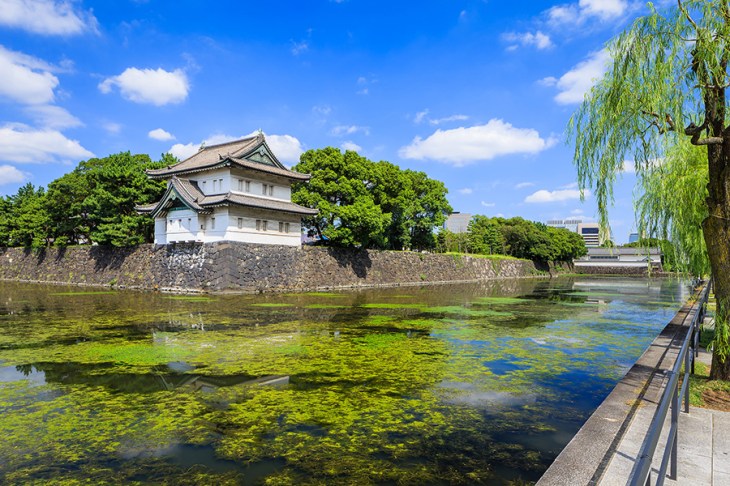Hello! Welcome to Our Site.
みなさん、こんにちは!私たちのサイトへようこそ。
Let’s talk about “Edo Castle(Imperial Palace).”
Do you know where Edo Castle is?
江戸城(皇居)について、紹介します。あなたは、江戸城のことをご存知ですか?
It is in the center of Tokyo, the capital of Japan. The Emperor and Empress live there. It is a castle but there is no buildings of the samurai period. Because there were a number of fires during the Edo period, and almost all buildings were burned down.
江戸城(皇居)は、日本の首都「東京」にあります。江戸城跡は皇居と呼ばれており、皇居には天皇・皇后が住んでいます。しかし、現在は江戸城の建物はありません。なぜなら、江戸時代に何度も火事で焼失しているからです。
Now let me introduce you the Edo Castle.
それでは、皇居について紹介します。
#01 江戸城(Edo Castle)の歴史・見どころ・旅ガイド

photo by wondertrip.jp
About Edo Castle|江戸城とは
Imperial Palace is formerly known as the Edo castle, the stronghold of the Tokugawa Shogunate. This palace has been the residence of the emperor of Japan since after the Meiji Restoration in 1868. The palace with a compound of 1.15 million square meters consists of the main palace where ceremonies and functions are held, the residence of the Emperor and Empress, and the East Garden containing the ruins of Tenshukaku Donjon. The Chowaden Hall, located in the main Imperial Palace, is noted for the New Year’s visit by the general public to the Imperial Palace.
江戸城(皇居)は、徳川幕府の拠点であるかつての江戸城として知られています。1868年の明治維新以降、皇居は天皇陛下が住んでいます。江戸城の敷地115万平方メートルでは、宮廷行事を行う宮殿、天皇皇后両陛下の住居である御所、天守閣跡を含む東御苑があります。宮殿内の長和殿は、新年の一般参賀で日本でも有名です。
Edo Castle is also known as Chiyodajo. It is situated in Chiyoda Ward, Tokyo. It was built between 1603 and 1651. Edo Castle was for over two centuries the headquarters of the Tokugawa shogunate (1603-1867). After the Meiji Restoration of 1868 the area encompassed by its inner moat became the Imperial Palace (Kokyo). Set off by broad moats and towering stone walls from the frenetic activity of the modern city, it survives today as a serene island of spacious gardens and woods.
江戸城は別名「千代田城」として知られています。江戸城が東京都千代田区にあるからです。江戸城は1603年から1651年におよそ50年もの歳月をかけて築城されました。江戸城は2世紀(約200年)以上、徳川幕府の中心でもありました。1868年の明治維新後、内堀で囲まれた部分が皇居(Imperial Palace)となりました。江戸城(皇居)は幅広い堀、そしてそびえたつ石垣で現代の街の喧騒から区切られ、今日まで広大な庭園と森の静かな島として生き残っているのです。
History of Edo Castle|江戸城の歴史とは
In 1590 Tokugawa Ieyasu was designated lord of the entire Kanto Plain by the national hegemon Toyotomi Hideyoshi. At the time, Edo (now Tokyo) was a coastal village, near which stood a small, dilapidated castle built by Ota Dokan in 1457. Making Edo their headquarters, Ieyasu and his successors set about constructing a castle that became the seat of shogunate rule in 1603. It served as the shogun’s residence, the center of his administrative bureaucracy, and the site of state receptions for daimyo making the formal visits stipulated by the Sankin Kotai regulations for alternate-year attendance in Edo.
1590年、徳川家康は国を統一した豊臣秀吉から関東一円の領主に任ぜられました。当時、江戸(現在の東京)は漁村で、江戸城の近くに1457年に太田道灌が建てた小さな荒れ城があったそうです。1603年、徳川家康とその後継者は江戸を政権の中心とするため、江戸幕府の本拠地となる城の建築に取り掛かりました。江戸城は将軍の住居、行政の中心、参勤交代制で規定された2年に一度の大名の謁見の場となりました。
Point 1|Scale of Edo Castle -江戸城の大きさとは-
When completed, the Edo castle was the largest in the world, its outer defensive perimeter (gaikaku) some 16 kilometers (10mi) in length. The inner defensive perimeter (naikaku), consisting of some 6.4 kilometers (4mi) of moats and walls, encircled what is now the Imperial Palace grounds.
江戸城は完成時、世界最大の城でした。江戸城の外郭の防衛線は、約16km。また、内堀が約6.4kmと石垣で出来ている内郭の防衛線は、現在の皇居の敷地を取り囲んでいます。
Point 2|Map of Edo Castle -江戸城の城内マップとは-
The heart of the castle was the main enclosure (hommaru), most of which was occupied by a rambling set of buildings that served as both the shogunal residence and the headquarters of his government and bureaucracy. The shogun’s personal chambers occupied the core of the castle buildings, the area called Nakaoku (Middle Interior). Directly to its north was the Ooku, or Great Inerior, where his womenfolk lived in a vast labyrinth of rooms and corridors.
江戸城の中心部は「本丸」と呼ばれます。本丸は、その大半が将軍の住居と幕府の中枢の両方の役割を果たす構造で長々と伸びた建物群となっていました。将軍の私的な部屋は、「中奥」と呼ばれる城の中心部の建物を占有。さらに北側に続くのが日本でも有名な「大奥」と呼ばれ、将軍のお女中たちが、各部屋と廊下からなる巨大な迷宮に住んでいました。
To the south was the Omote (Exterior) with its official offices and reception halls. Adjacent to the main enclosure was the western enclosure (nishinomaru), which usually served as the residence of the heir; the Momijiyama sector, with its shrines to former shoguns, Fukiage, and area of woods, walks, and gardens; and in the lower-lying plain to the east, and area occupied by the residence of shogunal officials.
江戸城南側は「表」で、御用部屋と謁見が行われる大広間があります。本丸の隣が「西の丸」で、世継ぎの住居となっています。紅葉山の辺りは歴代将軍の社である「吹上」があり、林が茂り、遊歩道や庭園が整備されています。東側の低地部分は将軍の家来の住居となっていました。
Point 3|Edo Castle, Now -現在の江戸城とは-
During the 1860s a series of disastrous fires destroyed the main building complexes of the castle; when Emperor Meiji located his capital in Edo in 1868. he inherited little more than a gutted shell. Most of the buildings on the grounds of the present Imperial Palace are of recent construction; only the moats and massive stonework of the perimeter remain as testament to the shogunal past.
1860年代、江戸城は一連の大火により城の主な建物は消失しました。1868年、明治天皇が都を江戸(東京)に定めたときは、焼け跡を受け継いだに過ぎなかったのです。現在の皇居にある建物のほとんどは、近年建築されたもの。江戸城周囲の堀と巨大な石垣のみが徳川将軍がいた過去の証として残っているだけですが今も現存しています。
Must of Edo Castle|江戸城で有名なスポットとは

photo by wondertrip.jp
Ote-mon Gate was once the main gate of Edo Castle. The narrow entrance is built in a style called Masugata-mon. Inside the gate is a rectangular space surrounded by stone walls where one must turn right to proceed to the next gate. Even if the enemy were to breach the first gate, they would be trapped inside this space and attacked with arrows or bullets through holes in the plaster parapets atop the stone walls.
大手門はかつては江戸城の正門でした。大手門の入り口は枡形門と呼ばれる狭い造りになっており、門の中は石垣に囲まれた桝の形で、次の門に進むには右に進まなければなりません。敵が最初の門を突破してもこの枡形の中に閉じ込められ、周囲の漆喰壁の上に設けられた穴から矢や鉄砲の弾で攻撃されることになります。
それでは、基本情報をご覧ください。
Edo Castle:Information|江戸城の基本情報
| 名称 | 皇居東御苑(旧江戸城) |
|---|---|
| 住所 | 東京都千代田区千代田1-1 |
| 電話 | 033-213-2050 |
| 営業時間 | 09:00-17:00(冬季16時まで) |
| 定休日 | 定休日あり(月曜日・金曜日) |
| 料金 | 大人 無料 |
| 子供 無料 | |
| アクセス | 最寄駅「JR東京駅」 |
| バス停「なし」 | |
| 駐車場 | 駐車場なし |
| 駐車料金 | 平日 -円 |
| 土日 -円 | |
| 祝日 -円 | |
| サービス | 駐車サービスなし |
| 登録日 | 2020年3月18日 |
| 更新日 | 2020年4月30日 |
※最新情報は、公式ホームページをご覧ください。
Vocabulary|本文中で使った単語
| capital | 首都 |
| formerly | 以前は、昔 |
| stronghold | 本拠、拠点 |
| residence | 住居 |
| compound | 構内 |
| inner moat | 内堀 |
| stone walls | 石垣 |
| frenetic activity | 喧騒 |
| serene | 静かな |
| designate | 任ずる |
| hegemon | 覇者 |
| dilapidated | 荒れ果てた |
| successor | 後継者 |
| stipulate | 規定する |
| narrow | 狭い |
| rectangular | 升形 |
| surround | 取り囲む |
| proceed | 前進する |
| breach | 突破する |
| parapet | 塁壁 |
Phrase|フレーズで覚えたい英語と日本語
| the Meiji Restoration | 明治維新 |
| New Year’s visit by the general public | 新年の一般参賀 |
| center of his administrative bureaucracy | 行政の中心 |
| frenetic activity of the modern city | 現代の街の喧騒 |
| vast labyrinth of rooms and corridors | 各部屋と廊下からなる巨大な迷宮 |
One Point Lesson|よく使う単語の使い方と違い

「見る」|「see」「look at」「watch」の違いと使い方 自然に「見る」こともあり、見ようとして「見る」こともあり、集中して「見る」こともある。英語の言い方を覚えておきましょう。 「見る」|「see」は自然に視覚に映る see は積極的に見る意志がなくて自然に視覚に映ることを表すとき...

「旅行」|「travel」「trip」「tour」の違いと使い方 「旅」には仕事や娯楽もあり、見学や視察もあり、短期や長期の旅もある。英語の言い方を覚えておきましょう。 「旅」|「travel」は仕事・娯楽の長距離旅行 travel は主に仕事・娯楽目的での長距離の旅行を漠然と表すときに使われ...

「場所」を英語で表現するとき「Place・Spot・Location」をどれを使う? 日本語で「場所」と言えば、一つ。 でも、英語で「場所」を表現するときには「place・spot・location」などの単語がありますね。日本語で場所は、漠然とその辺という意味。「場所」と言えば、 ...
Japanbook(ジャパンブック)では、日本の旅ガイドを紹介しています。日本全国の旅ガイドは、下記よりご覧ください。







